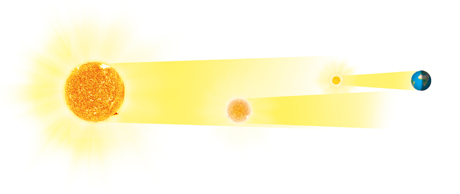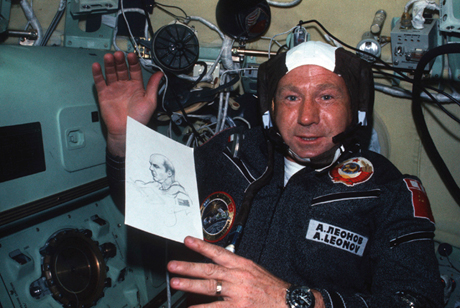“The Great Wall of China is visible from space”
The 2,200-year-old Chinese structure is impressive. But it cannot be observed from space – and certainly not from the Moon. Unless you have super-vision. In a blow for nationalist propaganda, back in 2003, China’s first astronaut, Yang Liwei, said that he could not spot the 6,350-km-long Great Wall of China from space. The myth dates back to the 1700s and has even been included in textbooks.
If the Chinese had painted the wall blue or pink, it may have been discernible. But the thin, faintly-coloured and partly overgrown dark bricks blend too well with the landscape to be seen from a spacecraft. From a low Earth orbit at 160 km, it’s theoretically possible to pick out the wall, if it is for instance covered in snow, which will make the structure light up.
But the fact is that barren desert roads and cities are easier to spot at this altitude. In some variants of the myth, it is said that the wall is even visible from the Moon. But the resolution of our eyes wrecks the myth. At a distance of 20 cm, the eye can separate out objects which are 0.06 mm apart. As the wall is approximately seven metres wide, and the distance to the Moon is 380,000 km, astronauts would need super-vision 17,000 times sharper than an ordinary human’s to see the wall – the same as spotting a strand of hair from a distance of 3.2 km.
“We only use 10% of our brain”
Reading this text requires 10% of your brain capacity, and if you get up for a coffee,the brain lights up in the parietal lobe, the occipital lobe, the frontal lobe, the cerebellum, the motor and sensory centres, and the basal ganglia. Any type of scan will demonstrate that almost the entire brain is more or less active at any time, even when we sleep.
This also explains, why around 20% of the body’s energy and oxygen are consumed by this 1.5-kg-heavy lump of wrinkly tissue. So how did the myth start?It’s unclear, but the introduction to American writer Dale Carnegie’s book “How to Win Friends and Influence People” from 1936 mentions it. It says that Harvard Professor William James used to claim that an average person only utilises 10% of his mental capacity and should thus exercise his brain. Maybe he was joking?
“There is no gravity in space”
The laws of gravity also apply to astronauts and spacecraft. Weightlessness is due to them being in a continous free fall. V ideo of astronauts hanging motionless in the air, sleeping, or exercising have lead to the myth that gravity does not exist in space. The expression “zero gravity” is even used for educational reasons by astronauts and physicists. And NASA has named its Glenn test centre the “Zero Gravity Research Facility”. But is “zero-g” a real thing?
Not in orbit it isn’t. Gravity, which is a force of attraction, exists everywhere. The Sun pulls all the planets. The Moon pulls the Earth, and even an apple has gravitational force, attracting its surroundings. If an astronaut travels away from a large mass such as the Earth, gravity is reduced – in the case of the International Space Station, by about 5%. But the station and the people inside itfloat, because they are in a constant free fall towards the Earth – but the curve of the planet and the speed of the ISS means they never hit the ground. Weight, but no acceleration The crew feels weightless inside the ISS, because the astronauts fall at the same speed as the space station.
They do not move relative to the structure and so never hit the floor. The fact that the “fall” feels like freedom from gravity has to do with gravitational acceleration – or a lack of it. At ground level, our bodies are pulled towards the centre of the planet by a force of 9.8 newtons per 1 kg of mass, – which corresponds to 1 g. In a free fall, you are not pushed against a surface, and in a spacecraft, there is no air resistance either. Consequently, the astronaut does not feel his mass acclerate toward the floor, which is what gives us weight. Free-fall is tricky though, as it will still take the astronaut the same amount of energy to move forward or back. If he crashes into something at speed, he can still be injured. Zero-g doesn’t affect his mass, just his perception of weight.
“The North Star is brighter than all other stars”
The myth that’s wrong… but also technically right. Seen from Earth, Sirius APPEARS as the brightest of all stars, but in fact the North Star is indeed a brighter star. It looks dimmer from the surface because it’s further away. But if all stars were the same distance, many others would be brighter than both of these… If you look at the northern sky on a starry night, the area around the North Star – also known as the Polaris – is deserted and dark. So many people (mostly northerners)wrongfully believe that it is the brightest of all stars.
However, the constellations of Canis Major contains a brighter light source: Sirius. It is 22 times brighter than the North Star, which is only 45th on the list of bright stars – after Rigel and Betelgeuse, among others. To be able to compare the brightness of stars, astronomers introduced a catalogue of sizes, which dates back to Greek astronomer Hipparchos. He divided the stars into six categories according to brightness. The brighter, the lower the category. Thus, Sirius was a category 1 star. In modern astronomy, the catalogue has grown, and a logarithmic formula has been introduced, adjusted according to our eyes’ way of detecting brightness. For example, the Sun is a category -26.74 star, if you measure its brightness as seen from Earth. Sirius is category -1.44 and the North Star is 1.97.
If you adjust for the stars’ distance from Earth, the picture is very different.
“Women have an extra rib”
In the Bible, God creates Eve out of one of Adam’s ribs, and so all men are supposed to lack one rib. In 1543, Belgian physician and anatomist Andreas Vesalius decided to make a count, and he caused a stir, when he revealed that both men and women have 12 sets of ribs – a total of 24.
However, approximately one in 200-500 people are born with an extra rib and this happens to slightly more women than men.
“Lightning never strikes the same place twice”
TV aerials and skyscrapers are struck by lightning several times a year. Actually, every lightning bolt dispels the myth, as even if it cannot be seen with the naked eye, a thunder cloud often sends a burst of lightning bolts towards the ground through the same path.
In microseconds, some 20 bursts strike the same place. A lightning bolt can also branch off, striking the ground in several places at the same time. In 2003, American meteorologists filmed 386 lightning bolts, as they struck in 558 different places. Each lightning bolt on average struck the ground in 1.45 places. The myth is rooted in an old saying illustrating the unlikelihood of a particular thing happening to the same person twice.
“You will explode in a vacuum”
In 1965, Russian cosmonaut Alexey Leonov learned the effect of the vacuum of space for himself, when he took the first space walk… though he did wear a spacesuit. A human being, who is subjected to a vacuum, will swell, because the air in the lungs expands, and the water of the soft tissue evaporates when the atmosphere is no longer compressing it.
After a few seconds, the person faints, and after a few minutes, he dies. But the body will not explode. That’s because everyone has an effective pressure suit built right in – their skin. At the Earth’s surface, each square centimetre of skin is subjected to a pressure of 1 atmosphere. The difference in relation to the space pressure of 0 kg/cm2 is actually not that significant. The stress is equivalent (though the reverse of) diving to about 10m. As far as pressure is con-cerned, a diver actually lives a more dangerous life than an astronaut. In the oceans, the pressure increases by 1 atmosphere for every 10 m.
A hundred metres down, the pressure has increased to 11 atmospheres. In fact it is divers who are at greatest risk of ”exploding” – they must return to the surface slowly, lest their lungs be damaged.
“The Moon has a dark side”
The moon has a near and a far side, but equal amounts of sunlight shine on them. There is no dark side. On the other hand, only the near side can be seen from Earth, as the Moon takes the exact same time to rotate its own axis as it takes to orbit the Earth once – it is ”tidally locked” to us. Consequently, the same side will always face the Earth.
On the other hand, the Moon’s far side will always be facing the outside of its orbit. When there’s a full moon, the sun is in front. A new moon is when the sun is behind – in this case the side we see is ”dark”. But it will get light again over the next month. Scientists call the distant side the ”far side” instead.
“Adults need 8 hours a night”
Some adults need 8 hours of sleep, others only 4, and yet others need at least 10 hours in bed to feel perfectly re-energised. The need for sleep is individual, and there is no scientific evidence that 8 hours is ideal for adults – though it is an effective average for most people.
Some doctors even believe that we should sleep at intervals. Up until the late 1700s, many people were awake for a few hours every night, processing dreams and experiences. It could even be that in some people, unbroken sleep may cause anxiety, depression, ironic sleeping problems, and drug abuse.
“A coin dropped from the Empire State Building can kill”
When construction of the Empire State Building in New York City ended in 1931, a popular legend emerged. If a visitor to the top floor, 381 m above the ground dropped a coin, it would reach the speed of a bullet before hitting the ground – which could kill an unfortunate pedestrian. But simple physics comes to the rescue of New Yorkers.
A coin is flat and circular, and the shape means that air resistance will quickly equal gravity. When it does, the coin cannot fall any faster, and after only 15 m, the coin will reach its top speed of about 40 km/h. At this speed, the coin will still hurt and maybe even injure if it hits, but it’s unlikely to kill. Also, this speed is difficult to calculate and depends on the weather and the coin’s rotation as it falls through the air. According to some estimates, a coin would be able to reach a speed of 100 km/h, but still be harmless.
Bullets are shot off at a speed of more than 1,000 km/h. Several people have tested the myth in practice. One of them is physicist Louis Bloomfield from the University of Virginia, who sent coins up and down wind tunnels with helium balloons to model the fall from a skyscraper and subsequently had the coins hit his forehead. The impact was felt, but he says it didn’t even hurt.
The Discovery Channel MythBusters TV series tested the myth in 2003. Coins were shot off at a speed of more than 100 km/h, and it was concluded that a falling coin can probably only cause harm, if it hits you in the eye. However, nails and pens should not be thrown from tall buildings, as they can cut through the air like arrows. While air molecules are constantly hitting a coin on its way down, they will glance off a pointed, thin object. A pen can reach a speed of more than 300 km/h, and when it strikes, it deposits its energy in a very small point – small enough to pierce a skull.
















